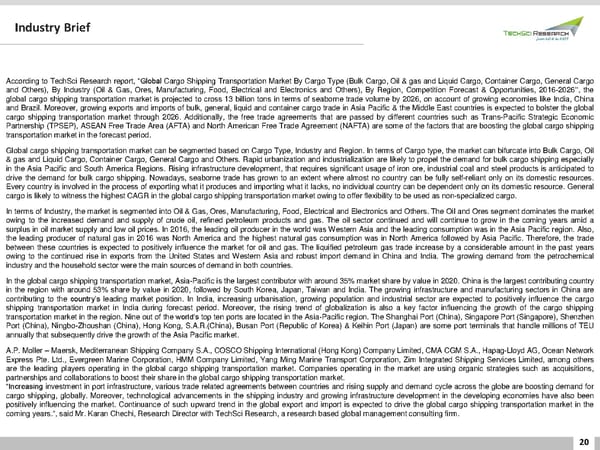Industry Brief According to TechSci Research report, “Global Cargo Shipping Transportation Market By Cargo Type (Bulk Cargo, Oil & gas and Liquid Cargo, Container Cargo, General Cargo and Others), By Industry (Oil & Gas, Ores, Manufacturing, Food, Electrical and Electronics and Others), By Region, Competition Forecast & Opportunities, 2016-2026’’, the global cargo shipping transportation market is projected to cross 13 billion tons in terms of seaborne trade volume by 2026, on account of growing economies like India, China and Brazil. Moreover, growing exports and imports of bulk, general, liquid and container cargo trade in Asia Pacific & the Middle East countries is expected to bolster the global cargo shipping transportation market through 2026. Additionally, the free trade agreements that are passed by different countries such as Trans-Pacific Strategic Economic Partnership (TPSEP), ASEAN Free Trade Area (AFTA) and North American Free Trade Agreement (NAFTA) are some of the factors that are boosting the global cargo shipping transportation market in the forecast period. Global cargo shipping transportation market can be segmented based on Cargo Type, Industry and Region. In terms of Cargo type, the market can bifurcate into Bulk Cargo, Oil &gasandLiquid Cargo, Container Cargo, General Cargo and Others. Rapid urbanization and industrialization are likely to propel the demand for bulk cargo shipping especially in the Asia Pacific and South America Regions. Rising infrastructure development, that requires significant usage of iron ore, industrial coal and steel products is anticipated to drive the demand for bulk cargo shipping. Nowadays, seaborne trade has grown to an extent where almost no country can be fully self-reliant only on its domestic resources. Every country is involved in the process of exporting what it produces and importing what it lacks, no individual country can be dependent only on its domestic resource. General cargo is likely to witness the highest CAGR in the global cargo shipping transportation market owing to offer flexibility to be used as non-specialized cargo. In terms of Industry, the market is segmented into Oil & Gas, Ores, Manufacturing, Food, Electrical and Electronics and Others. The Oil and Ores segment dominates the market owing to the increased demand and supply of crude oil, refined petroleum products and gas. The oil sector continued and will continue to grow in the coming years amid a surplus in oil market supply and low oil prices. In 2016, the leading oil producer in the world was Western Asia and the leading consumption was in the Asia Pacific region. Also, the leading producer of natural gas in 2016 was North America and the highest natural gas consumption was in North America followed by Asia Pacific. Therefore, the trade between these countries is expected to positively influence the market for oil and gas. The liquified petroleum gas trade increase by a considerable amount in the past years owing to the continued rise in exports from the United States and Western Asia and robust import demand in China and India. The growing demand from the petrochemical industry and the household sector were the main sources of demand in both countries. In the global cargo shipping transportation market, Asia-Pacific is the largest contributor with around 35% market share by value in 2020. China is the largest contributing country in the region with around 53% share by value in 2020, followed by South Korea, Japan, Taiwan and India. The growing infrastructure and manufacturing sectors in China are contributing to the country’s leading market position. In India, increasing urbanisation, growing population and industrial sector are expected to positively influence the cargo shipping transportation market in India during forecast period. Moreover, the rising trend of globalization is also a key factor influencing the growth of the cargo shipping transportation market in the region. Nine out of the world’s top ten ports are located in the Asia-Pacific region. The Shanghai Port (China), Singapore Port (Singapore), Shenzhen Port (China), Ningbo-Zhoushan (China), Hong Kong, S.A.R.(China), Busan Port (Republic of Korea) & Keihin Port (Japan) are some port terminals that handle millions of TEU annually that subsequently drive the growth of the Asia Pacific market. A.P. Moller – Maersk, Mediterranean Shipping Company S.A., COSCO Shipping International (Hong Kong) Company Limited, CMA CGM S.A., Hapag-Lloyd AG, Ocean Network Express Pte. Ltd., Evergreen Marine Corporation, HMM Company Limited, Yang Ming Marine Transport Corporation, Zim Integrated Shipping Services Limited, among others are the leading players operating in the global cargo shipping transportation market. Companies operating in the market are using organic strategies such as acquisitions, partnerships and collaborations to boost their share in the global cargo shipping transportation market. “Increasing investment in port infrastructure, various trade related agreements between countries and rising supply and demand cycle across the globe are boosting demand for cargo shipping, globally. Moreover, technological advancements in the shipping industry and growing infrastructure development in the developing economies have also been positively influencing the market. Continuance of such upward trend in the global export and import is expected to drive the global cargo shipping transportation market in the comingyears.”, said Mr. Karan Chechi, Research Director with TechSci Research, a research based global management consulting firm. 20
 GLOBAL CARGO SHIPPING TRANSPORTATION MARKET Page 19 Page 21
GLOBAL CARGO SHIPPING TRANSPORTATION MARKET Page 19 Page 21